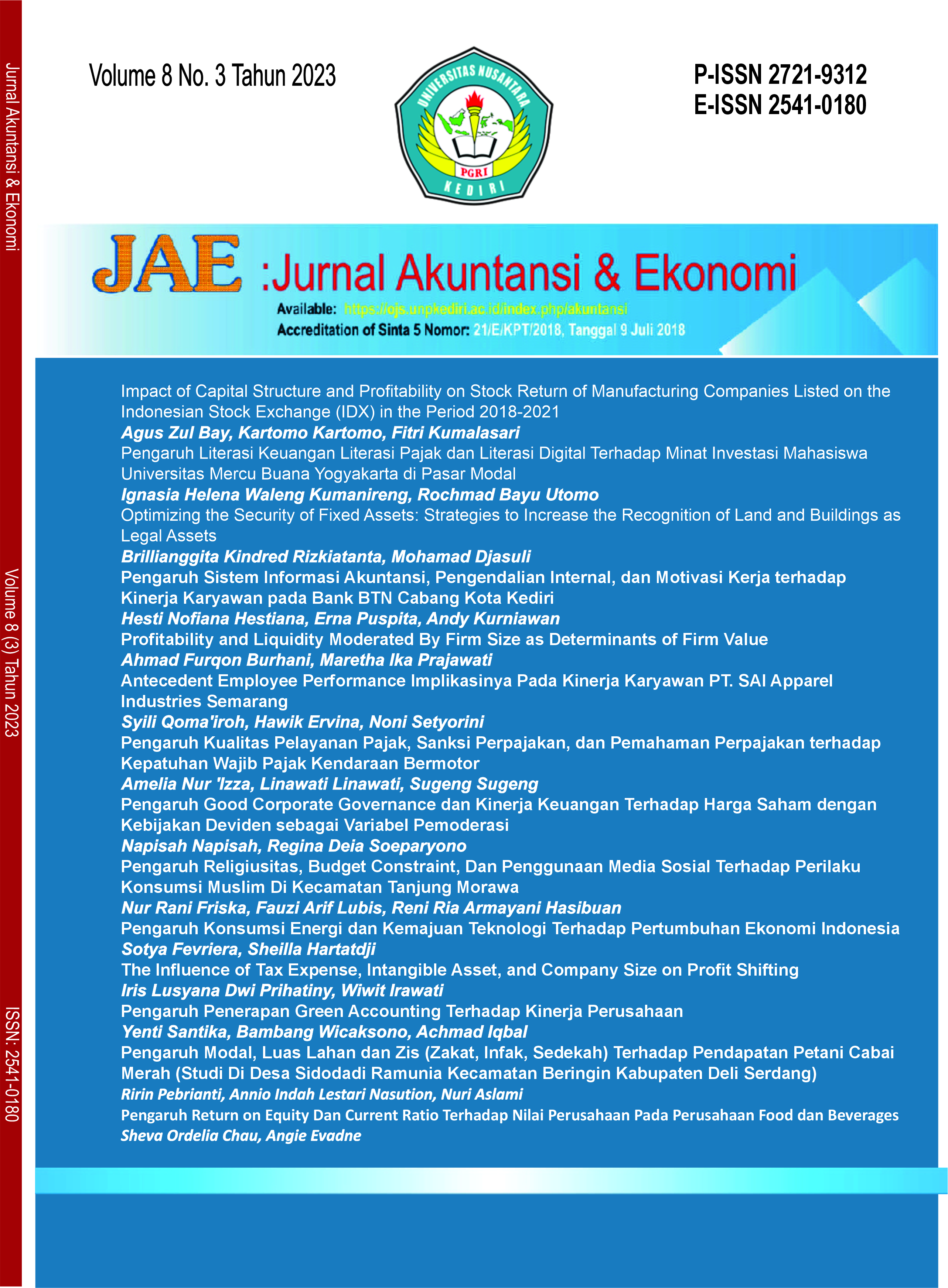The Influence of Tax Expense, Intangible Asset, and Company Size on Profit Shifting
DOI:
https://doi.org/10.29407/jae.v8i3.20928Keywords:
Tax Expense, Intangible Asset, Company Size, Profit ShiftingAbstract
This study aims to analyze the effect of tax expense, intangible assets, company size, and profit shifting. This study uses an associative quantitative approach. The population in this study are KOMPAS100 index company for 2017-2021 by taking financial report data on the Indonesia Stock Exchange. The metode of determining the sample used is purposive sampling. The tests used in this study are multiple regression analysis techniques, descriptive statistical test, panel data regression model analysis, selection model tests, multiple linear regression test, and hypothesis test with software eviews version 10. The result showed that there was partially it showed that the tax expense had an negative effect on profit shifting, while intangible assets and company size didn’t have effect on profit shifting.
References
Arifianto, M. D. (2012). Ekonometrika: esensi dan aplikasi dengan menggunakan EViews. Erlangga.
Boos, M. (2003). International business enterprises -- Taxation. Kluwer Law International.
Deanti, L. R. (2017). PENGARUH PAJAK, INTANGIBLE ASSETS, LEVERAGE, PROFITABILITAS, DAN TUNELLING INCENTIVE TERHADAP KEPUTUSAN TRANSFER PRICING PERUSAHAAN MULTINASIONAL INDONESIA (Vol. 93, Issue I). Universitas Islam Negeri Syarif Hidayatullah Jakarta.
Dahlia Amelia, Erviva Fariantin, I Made Murjana, Faisol, Ce Gunawan, Lukertina Sihombing, A. K. F. (2023). Kewirausahaan Berbasis UMKM. In SEVAL
Haliyah, N. S., Akhmad, S., & Andy, S. (2020). Pengaruh Tarif Pajak, Tunneling Incentive, dan Intangible Asset terhadap Keputusan Transfer Pricing. Business Management, Economic, and Accounting National Seminar, 1(1), 1059–1076.
Ilanoputri, S. A. (2022). PRINSIP KERAHASIAAN BANK DAN SELF ASSESSMENT SYSTEM DIKAITKAN DENGAN UNDANG-UNDANG AKSES INFORMASI. Dharmasisya: Jurnal Program Magister Hukum FKUI, 2(December), 39.
Ilmi, F., & Prastiwi, D. (2020). Pengaruh Profitabilitas, Inovasi Perusahaan dan Ukuran Perusahaan Terhadap Transfer Pricing Aggressiveness. Jurnal Akuntansi Unesa, 8(2), 1–9.
Jensen, M., & Meckling, W. . (1976). Theory of the Firm: Managerial behaviour, agency and ownership structure. Journal of Financial Economic, 2(3), 305–360.
Lestari, S., & Hasymi, M. (2022). Pengaruh Intangible Asset, Political Connection, dan Tunneling Incentives Terhadap Transfer Pricing Aggressiveness. Jurnal Riset Perbankan, Manajemen Dan Akuntansi, 3(2), 12–19.
Mulyaningrum, M., & Asalam, A. G. (2020). THE EFFECT OF TAX, PROFITABILITY AND BONUS MECHANISM ON TRANSFER PRICING (Study on Manufacturing Companies Listed in Indonesia Stock Exchange (BEI) Period 2017-2019). EProceeding of Engineering, 3(2), 1–9.
Novira, A. R., Suzan, L., & Asalam, A. G. (2020). Pengaruh Pajak, Intangible assets, dan Mekanisme Bonus Terhadap Keputusan Transfer pricing (Studi Kasus pada Perusahaan Sektor Pertambangan yang Terdaftar di Bursa Efek Indonesia Tahun 2015-2018). Journal of Applied Accounting and Taxation, 5(1), 17–23.
OECD. (2013). Education at aGlance 2013: OECD Indicators. OECD Publishing.
OECD. (2015). OECD/G20 Base Erosion and Profit Shifting Project Explanatory Statement.
Overesch, M. (2007). The Effects of Multinationals’ Profit Shifting Activities on Real Investments). ZEW Discussion Papers, 007(071), 1121–1134.
Prananda, R. ’Aisy, & Triyanto, D. N. (2020). Pengaruh Beban Pajak, Mekanisme Bonus, Exchange Rate, Dan Kepemilikan Asing Terhadap Indikasi Melakukan Transfer Pricing. Nominal: Barometer Riset Akuntansi Dan Manajemen, 9(2), 33–47. https://doi.org/10.21831/nominal.v9i2.30914
Puji Astuti, Faisol, S. (2023). Membangun kepatuhan wajib pajak umkm dengan peran keadilan pajak melalui kepercayaan wajib pajak. JAE (Jurnal Akuntansi Dan Ekonomi)J, 8(2), 104–112. https://doi.org/10.29407/jae.v8i2.20541
Putri, E. K. (2016). Pengaruh Kepemilikan Asing, Ukuran Perusahaan, dan Leverage Terhadap Keputusan Perusahaan Untuk Melakukan Transfer Pricing (Studi Pada Perusahaan Non Keuangan Yang Terdaftar Di Bursa Efek Indonesia Periode 2014) (Vol. 1, Issue 4). Universitas Islam Negeri Syarif Hidayatullah Jakarta.
Rakhmindyarto. (2014). Base Erosion and Profit Shifting (BEPS): Aktivitas Ekonomi Global dan Peran OECD.
Refgia, T., Ratnawati, V., & Rusli. (2017). Pengaruh Pajak, Mekanisme Bonus, Ukuran Perusahaan, Kepemilikan Asing, dan Tunneling Incentive terhadap Transfer Pricing (Perusahaan Sektor Industri Dasar dan Kimia yang Listing di BEI Tahun 2011-2014). JOM FeKon, 4(1), 543–555.
Richardson, G., & Taylor, G. (2015). Income Shifting Incentives and Tax Haven Utilization: Evidence from Multinational U.S. Firms. The International Journal of Accounting, 50(4), 458–485.
Rodiyah, C., & Supriadi. (2019). PENGARUH PROFITABILITAS,LEVERAGE, DAN UKURAN PERUSAHAAN TERHADAPEFFECTIVE TAX RATE(ETR) PADA PERUSAHAANMANUFAKTUR SUB SEKTOR MAKANAN DAN MINUMAN YANGTERDAFTAR DI BURSA EFEK INDONESIA TAHUN 2013 – 2016. Jurnal Analisa Akuntansi Dan Perpajakan, 3(1), 125–134.
Sugiyono. (2017). Metode Penelitian Kuantitatif, Kualitatif, dan R&D. Alfabeta.
Suntari, M., & Mulyani, S. D. (2020). Pengaruh Transfer Pricing dan Thin Capitalization terhadap Tax Aggressiveness dimoderasi oleh Ukuran Perusahaan. Prosiding Seminar Nasional Pakar, 2, 1–10. https://doi.org/https://doi.org/10.25105/pakar.v0i0.6829
Wafiroh, N. L. (2015). Pengaruh Pajak, Tunneling Incentive Dan Mekanisme Bonus Pada Keputusan Transfer Pricing Perusahaan Manufaktur Yang Listing Di Bursa Efek Indonesia (BEI) Periode 2011-2013. Universitas Islam Negeri (UIN) Maulana Malik Ibrahim Malang.
Waluyo. (2013). Perpajakan Indonesia. Salemba Empat.
Downloads
Published
Issue
Section
License
Authors who publish with this journal agree to the following terms:
- Copyright on any article is retained by the author(s).
- The author grants the journal, right of first publication with the work simultaneously licensed under a Creative Commons Attribution License that allows others to share the work with an acknowledgment of the work’s authorship and initial publication in this journal.
- Authors are able to enter into separate, additional contractual arrangements for the non-exclusive distribution of the journal’s published version of the work (e.g., post it to an institutional repository or publish it in a book), with an acknowledgment of its initial publication in this journal.
- Authors are permitted and encouraged to post their work online (e.g., in institutional repositories or on their website) prior to and during the submission process, as it can lead to productive exchanges, as well as earlier and greater citation of published work.
- The article and any associated published material is distributed under the Creative Commons Attribution-ShareAlike 4.0 International License







